
Subscribers to my posts through Feedblitz, are now entitled to enter a monthly withdraw that will offer an original postcard size watercolour.
On the first days of each month, the work will be shown and the withdraw will take place on the 10th.
One subscriber will be chosen (by an aleatory method) to win the painting. Substitutes will be chosen in the case of the lucky one does not want the painting (the substitutes will only be informed if the winner does not want the work).
The winner will not be eligible for the next month's withdraw.
When the winner accepts to receive the free painting, he/she will be responsible for shipping and handling : $5 USD to all the World, payed through Paypal (tm) or Money Order.
Winners from the following list of countries are exempt from paying shipping and handling.
The name of the winner/substitute and country (only this and no other personal info) will be announced, after being contacted by me.
Any contact as to influence the results of the withdraw will result on permanent removal from the list.
Kind regards,
José Carrilho







